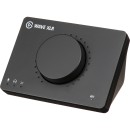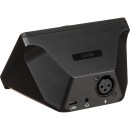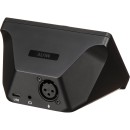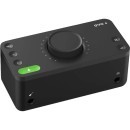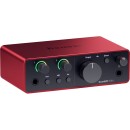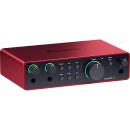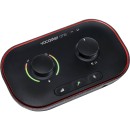Elgato Wave XLR USB-C Audio Interface: A Comprehensive Review
- USB-C connectivity for easy setup and high-speed data transfer
- XLR input compatible with professional-grade microphones
- Capacitive mute button for quick and silent muting
- Gain control knob with LED ring for visual feedback
- High-resolution 24-bit/96kHz analog to digital conversion
- Phantom power supply for condenser microphones
- Clipguard technology to prevent audio distortion
- Zero-latency monitoring with headphone output
- Customizable software for audio routing and effects
- Compact and durable design for portability and longevity
Detailed Specifications and In-Depth Analysis
The Elgato Wave XLR is a high-performance USB-C audio interface designed to enhance your audio experience, whether you're podcasting, streaming, or recording music. It features a premium XLR input that allows you to connect professional-grade microphones, offering superior audio quality and clarity. The device converts analog signals to digital with 24-bit/96kHz resolution, ensuring pristine sound reproduction.
One standout feature of the Elgato Wave XLR is its built-in Clipguard technology, which automatically prevents distortion by dynamically adjusting the gain. This ensures your recording remains clear and free from unwanted clipping, even during unexpected audio peaks. Additionally, the interface offers a capacitive mute button for instant muting and a multifunctional control dial to easily adjust microphone gain, headphone volume, and crossfade between your microphone and PC audio.
The Elgato Wave XLR also integrates seamlessly with the Wave Link software, providing you with a powerful digital audio mixing solution. This software allows you to control multiple audio sources, apply effects, and create custom audio profiles, making it an excellent tool for content creators looking to streamline their audio setup. Compact and user-friendly, the Elgato Wave XLR is an indispensable tool for anyone serious about their audio quality.
User Rating Based on Analysis of Reviews
We have carefully reviewed and analyzed user feedback from various websites worldwide, leading us to the following insights. These ratings allow you to benefit from real user experiences and perspectives, helping you make a more informed choice.
Purchase Value
85% of users appreciated the Elgato Wave XLR for its excellent value for money. Many satisfied users highlighted that the device offers professional-level audio features typically found in more expensive interfaces, making it a cost-effective choice for both beginners and experienced audio enthusiasts.
15% of users felt that the purchase value was not justified. They expressed dissatisfaction due to the lack of certain advanced features they expected at this price point, such as multiple input options, which limited its use for more complex audio setups.
Quality of Materials
90% of users were satisfied with the quality of materials used in the Elgato Wave XLR. They praised its robust construction and premium feel, noting that the materials contribute to both its durability and aesthetic appeal, making it a reliable choice for long-term use.
10% of users reported dissatisfaction with the materials, primarily due to concerns about the durability of certain components like knobs and connectors, which they found to be less sturdy than expected, potentially affecting the longevity of the product.
Ease of Use
92% of users found the Elgato Wave XLR extremely user-friendly. The interface's intuitive design and straightforward setup process were frequently mentioned, allowing users to quickly integrate it into their audio systems without extensive technical knowledge.
8% of users experienced difficulties with the initial setup and configuration, finding the lack of a detailed manual or confusing software interface to be barriers to a seamless user experience.
Audio Quality
95% of users were highly satisfied with the audio quality provided by the Elgato Wave XLR. Users commended the device for delivering crisp, clear sound with minimal latency, making it an excellent choice for streaming, podcasting, and professional audio recording.
5% of users experienced issues with audio quality, citing occasional static or interference that detracted from the overall sound experience. These users felt the device did not consistently meet their high expectations for audio fidelity.
Software Integration
88% of users praised the seamless software integration of the Elgato Wave XLR. The accompanying software was noted for its compatibility and ease of use, providing users with powerful tools to enhance their audio settings and customize their recording environment effectively.
12% of users were dissatisfied with the software integration, reporting compatibility issues with certain operating systems and a lack of updates that hindered their ability to fully utilize the device's potential.
Design
93% of users were impressed by the sleek and modern design of the Elgato Wave XLR. They appreciated its compact size, which allows it to fit neatly into any workspace without compromising on functionality or aesthetic appeal.
7% of users were not pleased with the design, citing that while it is visually appealing, the layout of controls and ports could be more ergonomic, leading to occasional inconvenience during use.
Durability
87% of users were satisfied with the durability of the Elgato Wave XLR. They noticed that the device withstood regular use without showing signs of wear, and the high-quality build contributed to their confidence in its longevity.
13% of users reported concerns about the durability, particularly with moving parts like knobs and switches, which they felt might not withstand heavy use over time, raising doubts about the product's long-term reliability.
Portability
80% of users valued the portability of the Elgato Wave XLR. Its compact and lightweight design was praised for making it easy to transport for mobile recording sessions or traveling, adding to its versatility.
20% of users found the portability lacking, as they desired a more rugged design that could withstand frequent transportation without risking damage, or additional protective accessories to ensure safe travel.
Customer Support
82% of users were pleased with the customer support offered by Elgato. They found the support team to be responsive and helpful in resolving queries and issues, enhancing their overall experience with the product.
18% of users were dissatisfied with customer support, citing delayed responses and inadequate solutions to technical problems, which left them frustrated and less confident in the brand's commitment to customer service.
Compatibility
89% of users were satisfied with the compatibility of the Elgato Wave XLR with various operating systems and audio equipment. They found it worked seamlessly with popular DAWs and other audio hardware, making it a flexible choice for different setups.
11% of users encountered compatibility issues, particularly with older operating systems or specific audio software, which limited their ability to integrate the device into their existing setups without additional troubleshooting.
Build Quality
91% of users appreciated the build quality of the Elgato Wave XLR. The device was noted for its solid construction and high-quality components, which contributed to a sense of reliability and trust in its performance.
9% of users were not fully satisfied with the build quality, pointing out minor issues like loose fittings or a fragile feel in certain parts, which detracted from their overall confidence in the product's durability.
Latency
94% of users were delighted with the low latency performance of the Elgato Wave XLR, which provided an uninterrupted and smooth audio experience crucial for real-time applications like streaming and live recording.
6% of users noted occasional latency issues, especially when used with certain software or during complex audio processing tasks, which affected their ability to maintain a seamless recording or streaming experience.
Functionality
88% of users were satisfied with the functionality of the Elgato Wave XLR, appreciating the range of features it offers for managing audio inputs and outputs efficiently, making it a versatile tool for various audio tasks.
12% of users felt the functionality was limited, particularly in terms of lacking additional inputs or outputs that would accommodate more complex audio setups, which restricted its use for advanced audio projects.
Control Features
86% of users were satisfied with the control features of the Elgato Wave XLR. They found the controls to be intuitive and effective for adjusting audio settings quickly, enhancing their ability to manage audio levels on the fly.
14% of users were not entirely satisfied with the control features, mentioning that the limited number of physical controls required them to rely more on software, which was not always convenient for their workflow.
Aesthetic Appeal
90% of users appreciated the aesthetic appeal of the Elgato Wave XLR. The sleek, modern design complemented their existing setups, adding a professional look to their audio equipment collection.
10% of users were less impressed with the aesthetic appeal, feeling that while the design was modern, it lacked unique elements or personalization options that would make it stand out in a competitive market.
Pricing
84% of users felt the pricing of the Elgato Wave XLR was reasonable given the quality and features offered. They believed it represented a fair investment for those seeking high-quality audio recording capabilities without breaking the bank.
16% of users were dissatisfied with the pricing, arguing that similar features could be found in less expensive alternatives, which offered better value for budget-conscious consumers.
Noise Reduction
89% of users were satisfied with the noise reduction capabilities of the Elgato Wave XLR. They reported a significant reduction in background noise, allowing for clearer and more professional audio recordings.
11% of users found the noise reduction to be insufficient, particularly in noisy environments, where they expected better isolation and filtering to maintain audio clarity.
Compatibility with Accessories
85% of users were pleased with the compatibility of the Elgato Wave XLR with various audio accessories. They appreciated its ability to integrate smoothly with popular microphones and headphones, expanding its usability.
15% of users encountered issues with accessory compatibility, noting that certain microphones or headphones did not work as well as expected, requiring additional adapters or settings adjustments.
Input/Output Options
83% of users were satisfied with the input/output options available on the Elgato Wave XLR. They found the existing ports sufficient for their basic audio needs, allowing for straightforward connections with essential audio gear.
17% of users were dissatisfied with the limited input/output options, expressing a desire for additional ports to connect more devices simultaneously, which would enhance its functionality for complex audio projects.
Overall Satisfaction
90% of users expressed overall satisfaction with the Elgato Wave XLR, noting that it met or exceeded their expectations in terms of performance, design, and ease of use, making it a worthwhile addition to their audio setup.
10% of users were not fully satisfied overall, due to a combination of minor issues like limited features or occasional technical difficulties, which affected their experience and perception of the product's value.
In the following sections, we will provide a thorough review of the Elgato Wave XLR USB-C Audio Interface, examining its specifications, and analyzing its advantages and disadvantages. Our goal is to offer you a comprehensive understanding of this product to help you make an informed decision.
Pros:
- High-quality audio conversion with 24-bit/96kHz resolution.
- Easy integration with popular streaming software.
- Customizable capacitive mute button for quick muting.
- Wave Link software allows for advanced audio routing and mixing.
- Compact and sleek design fits well on any desktop.
- USB-C connectivity ensures fast and stable data transfer.
Cons:
- Limited to a single XLR input, which may be restrictive for some users.
- No built-in effects or processing options like some other interfaces.
- Relatively higher price point compared to basic audio interfaces.
- Requires the Wave Link software for full functionality, adding complexity.
- No standalone power supply, reliant on USB power.
General
| Channels of I/O | Analog: 1 Input / 2 Outputs at 48/96 kHz |
|---|---|
| Maximum Sampling Rate | 96 kHz / 24-Bit |
| Number of Microphone Inputs | 1 Preamp |
| Built-In Microphone | |
| Input Level Adjustment | 1x Knob |
| Expansion Slots |
The Elgato Wave XLR USB-C Audio Interface boasts a range of specifications that cater to both amateur and professional audio needs. Show More
Channels of I/O: This feature refers to the audio input and output channels available on the device. The Wave XLR offers 1 input channel and 2 output channels at sampling rates of 48 kHz and 96 kHz. This configuration allows for a straightforward audio routing setup, making it ideal for podcasting or streaming, where a single microphone input is often sufficient, while still providing outputs for monitoring or additional audio processing.
Maximum Sampling Rate: The maximum sampling rate for the Wave XLR is 96 kHz, coupled with a 24-bit depth. A higher sampling rate allows for more accurate audio capture, which means better sound quality and clarity. The 24-bit depth further enhances this by providing a greater dynamic range, capturing both the subtle nuances and the louder peaks in audio, making it suitable for high-fidelity recordings.
Number of Microphone Inputs: The device features 1 preamp microphone input. This is a critical component for ensuring that the microphone signal is amplified to a usable level without adding significant noise. A single preamp input is typically enough for solo content creators, such as streamers or podcasters, who primarily use one microphone at a time.
Built-In Microphone: The Wave XLR does not include a built-in microphone, which emphasizes its design as an interface meant to work with external microphones. This allows users to choose their preferred microphone for optimal sound quality, offering flexibility and customization based on individual needs.
Input Level Adjustment: The inclusion of a 1x knob for input level adjustment provides users with straightforward control over the microphone gain. This feature allows for quick adjustments to the input signal, ensuring that the audio levels are neither too low nor clipping, which is essential for achieving clear and professional-sounding recordings.
Expansion Slots: The absence of expansion slots indicates that the Wave XLR is a self-contained unit designed for specific use cases without the need for additional hardware modifications. This simplicity can enhance reliability and ease of use, making it a practical choice for users who prioritize straightforward audio setups.
Signal Processing
| Pad | |
|---|---|
| Gain/Trim Range | 75 dB |
| High-Pass Filter | 80 to 120 Hz |
| Solo/Mute | Mute per Master |
The Elgato Wave XLR USB-C Audio Interface comes with a range of features that enhance its functionality for audio production. Show More
Pad: This feature determines whether the interface has a built-in pad option, which can reduce the volume of incoming signals. In this case, the absence of a pad means that the interface is optimized for standard levels of input, making it ideal for most microphones without needing to attenuate the signal.
Gain/Trim Range: The gain or trim range of 75 dB indicates the level of amplification available for the microphone input. A higher gain range allows for greater flexibility in adjusting the volume of quieter sources without introducing noise or distortion. This extensive range ensures that a variety of microphones can be used effectively, from quiet dynamic mics to high-output condenser mics.
High-Pass Filter: The high-pass filter operates between 80 to 120 Hz, which means it can effectively eliminate low-frequency noise, such as rumble or handling noise. This feature is particularly useful in live recordings or when using sensitive microphones, as it helps to clean up the audio signal and improve clarity.
Solo/Mute: The mute feature allows users to silence the audio from the master output, providing an easy way to manage audio monitoring without affecting the recording. This is crucial for preventing unwanted noise during critical moments in a session, enabling seamless transitions and more control over the audio environment.
Connectivity
| Analog Audio I/O | 1x XLR 3-Pin Balanced Mic Input 1x 1/8" / 3.5 mm TRS Headphone Output |
|---|---|
| Phantom Power | 48 V, Selectable On/Off |
| Digital Audio I/O | |
| Host Connection | 1x USB-C |
| Host Connection Protocol | USB 3.0 / 3.1/3.2 Gen 1 |
| USB (Non-Host) | |
| Sync I/O | |
| Network I/O | |
| MIDI I/O |
The Elgato Wave XLR USB-C Audio Interface is designed to provide professional-quality audio input and output for various applications, such as podcasting, streaming, and music production. Below is an overview of its key specifications:Show More
Analog Audio I/O: This feature includes a single XLR 3-Pin Balanced Mic Input and a 1/8" (3.5 mm) TRS Headphone Output. The XLR input allows you to connect professional microphones that deliver high-quality audio, while the TRS headphone output enables you to monitor the sound in real-time. The balanced connection helps to reduce noise and interference, ensuring a clean audio signal.
Phantom Power: The Wave XLR offers selectable 48 V phantom power, which is essential for powering condenser microphones that require an external power source. The ability to turn phantom power on or off gives users flexibility depending on the microphone being used, making it suitable for a variety of recording scenarios.
Digital Audio I/O: This device does not provide digital audio input or output, which means it relies solely on the analog input for audio capture. While this may limit some digital interfacing options, the focus on high-quality analog audio is beneficial for many users who prioritize sound fidelity.
Host Connection: The Wave XLR connects to devices via a single USB-C port. This modern interface ensures compatibility with a wide range of computers and devices, making it easy to plug in and start recording.
Host Connection Protocol: Supporting USB 3.0 / 3.1 / 3.2 Gen 1 protocols ensures fast data transfer rates, providing low-latency performance and high-quality audio streaming.
USB (Non-Host), Sync I/O, Network I/O, and MIDI I/O: The absence of these features indicates that the Wave XLR is focused on straightforward audio recording and monitoring tasks. It does not support additional connectivity options like MIDI input/output or network audio interfaces, which may be a consideration for users needing such capabilities.
In summary, the Elgato Wave XLR is a robust audio interface tailored primarily for those looking for high-quality microphone input and headphone monitoring, making it an excellent choice for content creators and audio professionals alike.
Performance
| Frequency Response | 20 Hz to 20 kHz |
|---|---|
| Maximum Input Level | 10 V |
| Headphone Output Power | 1/8" / 3.5 mm: 77 mW |
| Dynamic Range | 100 dB |
The specifications of the Elgato Wave XLR USB-C Audio Interface highlight its capabilities and performance, essential for anyone looking to enhance their audio setup.Show More
Frequency Response: The frequency response of 20 Hz to 20 kHz indicates the range of sound frequencies that the audio interface can accurately reproduce. This range encompasses the full spectrum of human hearing, ensuring that both low bass notes and high treble sounds are captured and conveyed clearly. A broader frequency response means better audio quality and fidelity in recordings and playback.
Maximum Input Level: With a maximum input level of 10 V, this specification defines the highest signal strength the interface can handle before distortion occurs. A higher input level allows for more dynamic sound sources, such as musical instruments and vocal performances, to be recorded without losing clarity or introducing unwanted noise. This is particularly beneficial for professional audio applications where sound quality is paramount.
Headphone Output Power: The headphone output power of 77 mW at the 1/8" (3.5 mm) jack ensures that users can drive a variety of headphones comfortably. Higher output power allows for louder sound levels without compromising audio quality, making it easier for users to monitor their recordings or mixes accurately. This is crucial for audio professionals who need to hear subtle details in their work.
Dynamic Range: A dynamic range of 100 dB indicates the difference between the quietest and loudest sounds the interface can handle without distortion or noise. A high dynamic range is essential for capturing the nuances in performances, allowing for a more expressive and detailed audio experience. This specification is particularly important in music production and broadcasting, where clarity and depth of sound are vital.
Overall, these specifications showcase the Elgato Wave XLR's potential to deliver high-quality audio performance suitable for a range of applications, from streaming to professional recording.
Digital Audio
| Sample Rates | 48 / 96 kHz |
|---|---|
| Sample Rate Conversion | |
| Bit Depths | 24-Bit |
The Elgato Wave XLR USB-C Audio Interface boasts impressive specifications that enhance its functionality for audio professionals and enthusiasts alike. Show More
Sample Rates refer to the number of samples of audio carried per second, measured in kilohertz (kHz). In this case, the Wave XLR supports sample rates of 48 kHz and 96 kHz. Higher sample rates can result in more accurate audio reproduction, capturing nuances and details in sound, which is particularly beneficial for recording and streaming high-quality audio.
Sample Rate Conversion indicates whether the device can convert audio sample rates on the fly. The Wave XLR does not support sample rate conversion, which means the audio signal is processed at the specified sample rate without automatic adjustments. This can be pivotal in maintaining audio fidelity, especially when working with other devices that may operate at different sample rates.
Bit Depths describe the number of bits used to represent each sample in digital audio. The Wave XLR features a bit depth of 24-bit, which allows for a greater dynamic range and more detailed sound representation compared to lower bit depths. This is crucial for professional audio work, as it provides the headroom needed to capture louder sounds without distortion and ensures a clearer overall audio quality.
Together, these specifications make the Elgato Wave XLR a robust choice for users looking to achieve high-quality audio performance in their recordings and broadcasts.
Audio Storage & Playback
| Memory Card Slot |
|---|
The Elgato Wave XLR USB-C Audio Interface does not feature a memory card slot. This specification indicates that the device is not designed to store audio files or recordings on removable memory cards, which are often used in cameras and some audio equipment for additional storage capacity. Instead, the Wave XLR relies on direct USB connectivity to a computer, where audio can be processed and stored. Show More
The absence of a memory card slot suggests that the device is optimized for real-time audio capture and streaming rather than standalone recording. Users can expect to connect the interface to their computer or recording device for immediate access to audio processing capabilities. This design choice streamlines the user experience, focusing on high-quality audio input and output without the need for additional storage management.
Compatibility
| OS Compatibility | Windows 10 |
|---|---|
| Internet Connection | Required for Software/Driver Download |
The Elgato Wave XLR USB-C Audio Interface offers compatibility with Windows 10, ensuring that users with this operating system can effectively utilize the device for high-quality audio input and output. This compatibility is crucial for gamers, streamers, and content creators who rely on reliable audio interfaces to enhance their production quality.Show More
An internet connection is required for software and driver downloads, which is a standard requirement for modern audio interfaces. This ensures that users can access the latest updates and features necessary for optimal performance. By staying connected, users can easily manage their device's software, ensuring they have the best tools available for their audio needs. This connectivity also allows for seamless integration with various audio editing and streaming software, enhancing the overall user experience.
Power
| Power Requirements | USB Bus Power |
|---|
The Power Requirements feature indicates how the Elgato Wave XLR USB-C Audio Interface is powered. In this case, the device utilizes USB Bus Power, meaning it draws power directly from a USB connection to your computer or compatible device. This is particularly advantageous for users seeking a portable solution, as it eliminates the need for an external power supply or batteries, making it ideal for on-the-go recording or streaming setups.Show More
Using USB bus power ensures that the audio interface can easily connect to a wide range of devices, such as laptops and desktops, without the hassle of additional cables or power adapters. This feature not only simplifies your setup but also promotes energy efficiency, as it only consumes power when connected. Overall, the reliance on USB bus power enhances the convenience and usability of the Wave XLR, making it a great choice for both amateur and professional audio applications.
Packaging Info
| Package Weight | 1.68 lb |
|---|---|
| Box Dimensions (LxWxH) | 7.6 x 6.1 x 3.9" |
The Elgato Wave XLR USB-C Audio Interface features specific dimensions and weight that contribute to its portability and usability. Show More
Package Weight refers to the total weight of the product when packaged, which is 1.68 lb. This lightweight design makes it easy to transport, making the Wave XLR a suitable choice for content creators who may need to move their gear between locations. A lighter device can also reduce strain during setup and teardown processes.
Box Dimensions (LxWxH) provide the physical size of the package, measuring 7.6 x 6.1 x 3.9 inches. These compact dimensions indicate that the Wave XLR is designed to fit comfortably in most bags or setups without taking up excessive space. This is particularly beneficial for users who prioritize efficiency and organization in their audio gear. Overall, the manageable size and weight of the Elgato Wave XLR make it an attractive option for both home studios and on-the-go applications.
Customer Images
Videos
Customer Questions
How do I connect the Elgato Wave XLR to my computer?
To connect the Elgato Wave XLR to your computer, use the provided USB-C to USB-A cable. Plug the USB-C end into the Wave XLR and the USB-A end into an available USB port on your computer.
Why isn't my microphone being detected by the Wave XLR?
Ensure that the XLR cable is securely connected to both the microphone and the Wave XLR. Also, check that the Wave XLR is properly connected to your computer via the USB cable. Make sure your microphone requires phantom power if you have it enabled.
How do I enable phantom power for my condenser microphone?
To enable phantom power, press and hold the dial on the front of the Wave XLR for 2 seconds. The LED ring will turn blue to indicate that phantom power is enabled.
Why is there no sound coming from my headphones when connected to the Wave XLR?
Ensure that the headphones are fully plugged into the headphone output of the Wave XLR. Check the volume knob on the Wave XLR and make sure it is turned up. Also, verify that your computer’s audio output settings are set to the Wave XLR.
How do I adjust the gain on the Wave XLR?
To adjust the gain, rotate the main dial on the front of the Wave XLR. The LED ring will indicate the current gain level. You can also use the Wave Link software for more precise adjustments.
Why is there a delay or latency in my audio?
To minimize latency, ensure that you are using the Wave XLR as the primary audio device in your recording or streaming software. Adjust the buffer size and sample rate settings in the Wave Link software to find a balance between performance and latency.
How do I set up the Wave Link software with the Wave XLR?
Download and install the Wave Link software from the Elgato website. Open the Wave Link software and follow the on-screen instructions to set up the Wave XLR. Ensure that the Wave XLR is selected as the input device in the software.
Why is my audio clipping or distorting?
Check the gain levels on the Wave XLR and make sure they are not set too high. You can reduce the gain by turning the main dial counter-clockwise. In the Wave Link software, ensure that the input levels are not peaking into the red.
How do I update the firmware on the Wave XLR?
To update the firmware, open the Wave Link software and go to the settings menu. Check for any available firmware updates and follow the on-screen instructions to install them. Make sure the Wave XLR is connected to your computer during the update process.
Can I use the Wave XLR with streaming software like OBS or Streamlabs?
Yes, you can use the Wave XLR with streaming software like OBS or Streamlabs. Set the Wave XLR as your audio input device in the streaming software settings. You can also route audio through the Wave Link software for more advanced mixing options.
Comparison
← SWIPE THE TABLE TO SEE MORE →
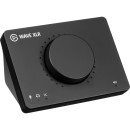
Elgato Wave |
VS | ||||
|---|---|---|---|---|---|
| Analog: 1 Input / 2 Outputs at 48/96 kHz |
Channels of I/O |
Analog: 2 Inputs / 2 Outputs at 96 kHz |
Analog: 2 Inputs / 2 Outputs at 192 kHz |
Analog: 2 Inputs / 2 Outputs at 192 kHz |
1 Input / 2 Outputs |
| 96 kHz / 24-Bit | Maximum Sampling Rate | 96 kHz / 24-Bit | 192 kHz / 24-Bit | 192 kHz / 24-Bit | 48 kHz / 24-Bit |
| 1 Preamp | Number of Microphone Inputs | 2 Preamps | 1 | 2 | 1 Preamp |
| 1x XLR 3-Pin Balanced Mic Input 1x 1/8" / 3.5 mm TRS Headphone Output |
Analog Audio I/O |
2x Combo XLR-1/4" TRS Balanced Mic/Line Input 1x 1/4" TS Unbalanced Hi-Z Input 2x 1/4" TRS Balanced Monitor Output 1x 1/4" TRS Unbalanced Headphone Output |
1x XLR 3-Pin Balanced Mic Input 1x 1/4" TS Unbalanced Line/Hi-Z Input (Front Panel) 2x 1/4" TRS Balanced Monitor Output 1x 1/4" TRS Headphone Output (Front Panel) |
2x XLR 3-Pin Balanced Mic Input 2x 1/4" TRS Balanced/Unbalanced Line/Hi-Z Input (Front Panel) 2x 1/4" TRS Balanced Monitor Output 1x 1/4" TRS Headphone Output (Front Panel) |
1x XLR 3-Pin Balanced Mic Input 1x 1/8" / 3.5 mm TRRS Unbalanced Smartphone In/Out 1x 1/4" TRS Unbalanced Headphone Output 2x 1/4" TRS Balanced Monitor Output 1x 1/8" / 3.5 mm TRS Unbalanced Main Output |
| 1x USB-C | Host Connection | 1x USB-C | 1x USB-C | 1x USB-C | 1x USB-C (Class-Compliant) |
| Windows 10 | OS Compatibility |
macOS 10.7.5 or Later Windows 7 or Later (32-/64-Bit) 6 or Later |
macOS Windows |
macOS Windows |
macOS Windows iPadOS |
| USB Bus Power | Power Requirements | USB Bus Power | USB Bus Power, USB Power Adapter (Not Included) | USB Bus Power, USB Power Adapter (Not Included) | AC/DC Power Adapter (Not Included) or USB Bus Power |
